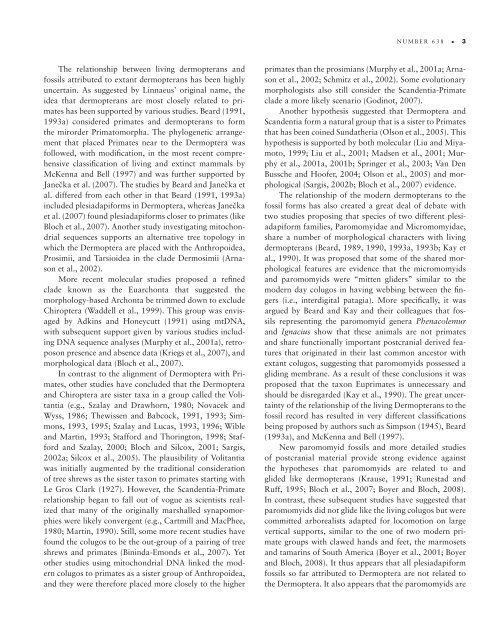Gliding Mammals: Taxonomy of Living and Extinct Species
Gliding Mammals: Taxonomy of Living and Extinct Species
Gliding Mammals: Taxonomy of Living and Extinct Species
You also want an ePaper? Increase the reach of your titles
YUMPU automatically turns print PDFs into web optimized ePapers that Google loves.
The relationship between living dermopterans <strong>and</strong><br />
fossils attributed to extant dermopterans has been highly<br />
uncertain. As suggested by Linnaeus’ original name, the<br />
idea that dermopterans are most closely related to primates<br />
has been supported by various studies. Beard (1991,<br />
1993a) considered primates <strong>and</strong> dermopterans to form<br />
the mirorder Primatomorpha. The phylogenetic arrangement<br />
that placed Primates near to the Dermoptera was<br />
followed, with modification, in the most recent comprehensive<br />
classification <strong>of</strong> living <strong>and</strong> extinct mammals by<br />
McKenna <strong>and</strong> Bell (1997) <strong>and</strong> was further supported by<br />
Janečka et al. (2007). The studies by Beard <strong>and</strong> Janečka et<br />
al. differed from each other in that Beard (1991, 1993a)<br />
included plesiadapiforms in Dermoptera, whereas Janečka<br />
et al. (2007) found plesiadapiforms closer to primates (like<br />
Bloch et al., 2007). Another study investigating mitochondrial<br />
sequences supports an alternative tree topology in<br />
which the Dermoptera are placed with the Anthropoidea,<br />
Prosimii, <strong>and</strong> Tarsioidea in the clade Dermosimii (Arnason<br />
et al., 2002).<br />
More recent molecular studies proposed a refined<br />
clade known as the Euarchonta that suggested the<br />
morphology- based Archonta be trimmed down to exclude<br />
Chiroptera (Waddell et al., 1999). This group was envisaged<br />
by Adkins <strong>and</strong> Honeycutt (1991) using mtDNA,<br />
with subsequent support given by various studies including<br />
DNA sequence analyses (Murphy et al., 2001a), retroposon<br />
presence <strong>and</strong> absence data (Kriegs et al., 2007), <strong>and</strong><br />
morphological data (Bloch et al., 2007).<br />
In contrast to the alignment <strong>of</strong> Dermoptera with Primates,<br />
other studies have concluded that the Dermoptera<br />
<strong>and</strong> Chiroptera are sister taxa in a group called the Volitantia<br />
(e.g., Szalay <strong>and</strong> Drawhorn, 1980; Novacek <strong>and</strong><br />
Wyss, 1986; Thewissen <strong>and</strong> Babcock, 1991, 1993; Simmons,<br />
1993, 1995; Szalay <strong>and</strong> Lucas, 1993, 1996; Wible<br />
<strong>and</strong> Martin, 1993; Stafford <strong>and</strong> Thorington, 1998; Stafford<br />
<strong>and</strong> Szalay, 2000; Bloch <strong>and</strong> Silcox, 2001; Sargis,<br />
2002a; Silcox et al., 2005). The plausibility <strong>of</strong> Volitantia<br />
was initially augmented by the traditional consideration<br />
<strong>of</strong> tree shrews as the sister taxon to primates starting with<br />
Le Gros Clark (1927). However, the Sc<strong>and</strong>entia- Primate<br />
relationship began to fall out <strong>of</strong> vogue as scientists realized<br />
that many <strong>of</strong> the originally marshalled synapomorphies<br />
were likely convergent (e.g., Cartmill <strong>and</strong> MacPhee,<br />
1980; Martin, 1990). Still, some more recent studies have<br />
found the colugos to be the out- group <strong>of</strong> a pairing <strong>of</strong> tree<br />
shrews <strong>and</strong> primates (Bininda- Emonds et al., 2007). Yet<br />
other studies using mitochondrial DNA linked the modern<br />
colugos to primates as a sister group <strong>of</strong> Anthropoidea,<br />
<strong>and</strong> they were therefore placed more closely to the higher<br />
NUMBER 638 • 3<br />
primates than the prosimians (Murphy et al., 2001a; Arnason<br />
et al., 2002; Schmitz et al., 2002). Some evolutionary<br />
morphologists also still consider the Sc<strong>and</strong>entia- Primate<br />
clade a more likely scenario (Godinot, 2007).<br />
Another hypothesis suggested that Dermoptera <strong>and</strong><br />
Sc<strong>and</strong>entia form a natural group that is a sister to Primates<br />
that has been coined Sundatheria (Olson et al., 2005). This<br />
hypothesis is supported by both molecular (Liu <strong>and</strong> Miyamoto,<br />
1999; Liu et al., 2001; Madsen et al., 2001; Murphy<br />
et al., 2001a, 2001b; Springer et al., 2003; Van Den<br />
Bussche <strong>and</strong> Ho<strong>of</strong>er, 2004; Olson et al., 2005) <strong>and</strong> morphological<br />
(Sargis, 2002b; Bloch et al., 2007) evidence.<br />
The relationship <strong>of</strong> the modern dermopterans to the<br />
fossil forms has also created a great deal <strong>of</strong> debate with<br />
two studies proposing that species <strong>of</strong> two different plesiadapiform<br />
families, Paromomyidae <strong>and</strong> Micromomyidae,<br />
share a number <strong>of</strong> morphological characters with living<br />
dermopterans (Beard, 1989, 1990, 1993a, 1993b; Kay et<br />
al., 1990). It was proposed that some <strong>of</strong> the shared morphological<br />
features are evidence that the micromomyids<br />
<strong>and</strong> paromomyids were “mitten gliders” similar to the<br />
modern day colugos in having webbing between the fingers<br />
(i.e., interdigital patagia). More specifically, it was<br />
argued by Beard <strong>and</strong> Kay <strong>and</strong> their colleagues that fossils<br />
representing the paromomyid genera Phenacolemur<br />
<strong>and</strong> Ignacius show that these animals are not primates<br />
<strong>and</strong> share functionally important postcranial derived features<br />
that originated in their last common ancestor with<br />
extant colugos, suggesting that paromomyids possessed a<br />
gliding membrane. As a result <strong>of</strong> these conclusions it was<br />
proposed that the taxon Euprimates is unnecessary <strong>and</strong><br />
should be disregarded (Kay et al., 1990). The great uncertainty<br />
<strong>of</strong> the relationship <strong>of</strong> the living Dermopterans to the<br />
fossil record has resulted in very different classifications<br />
being proposed by authors such as Simpson (1945), Beard<br />
(1993a), <strong>and</strong> McKenna <strong>and</strong> Bell (1997).<br />
New paromomyid fossils <strong>and</strong> more detailed studies<br />
<strong>of</strong> postcranial material provide strong evidence against<br />
the hypotheses that paromomyids are related to <strong>and</strong><br />
glided like dermopterans (Krause, 1991; Runestad <strong>and</strong><br />
Ruff, 1995; Bloch et al., 2007; Boyer <strong>and</strong> Bloch, 2008).<br />
In contrast, these subsequent studies have suggested that<br />
paromomyids did not glide like the living colugos but were<br />
committed arborealists adapted for locomotion on large<br />
vertical supports, similar to the one <strong>of</strong> two modern primate<br />
groups with clawed h<strong>and</strong>s <strong>and</strong> feet, the marmosets<br />
<strong>and</strong> tamarins <strong>of</strong> South America (Boyer et al., 2001; Boyer<br />
<strong>and</strong> Bloch, 2008). It thus appears that all plesiadapiform<br />
fossils so far attributed to Dermoptera are not related to<br />
the Dermoptera. It also appears that the paromomyids are

















